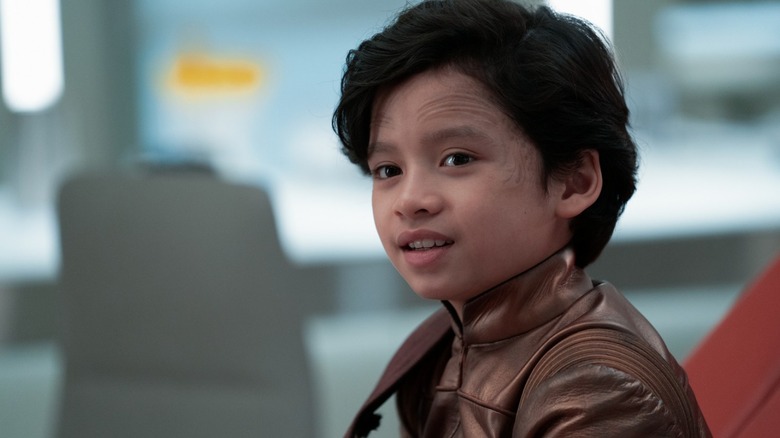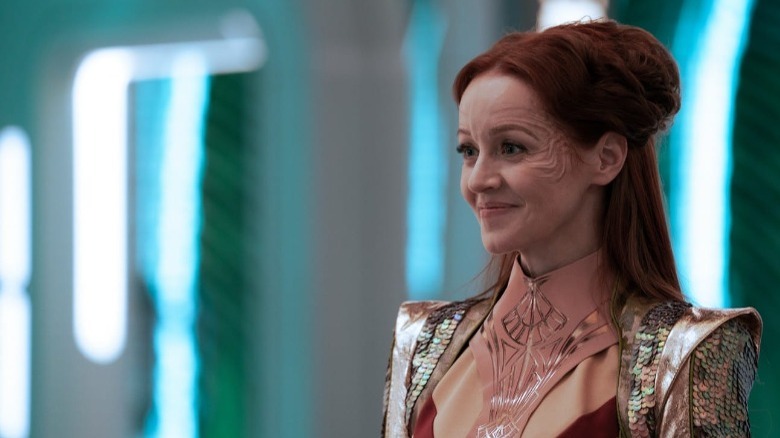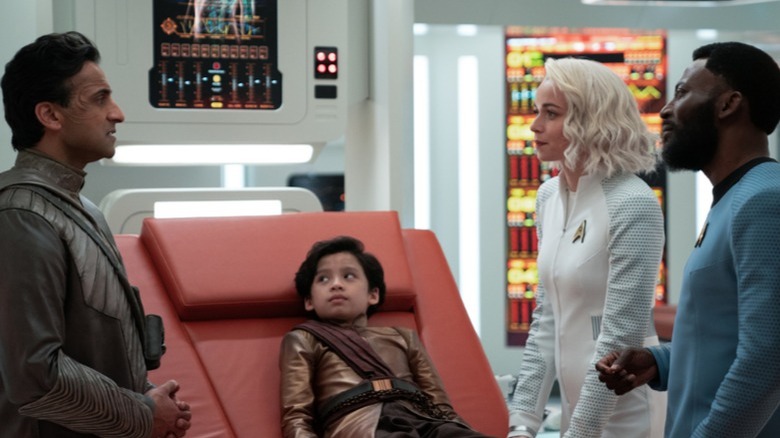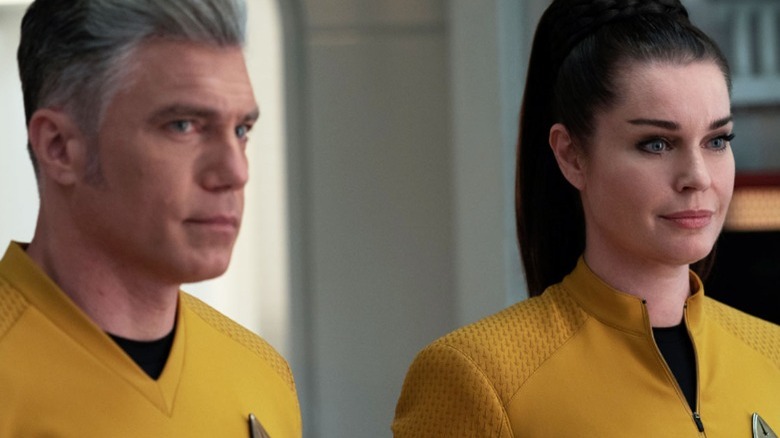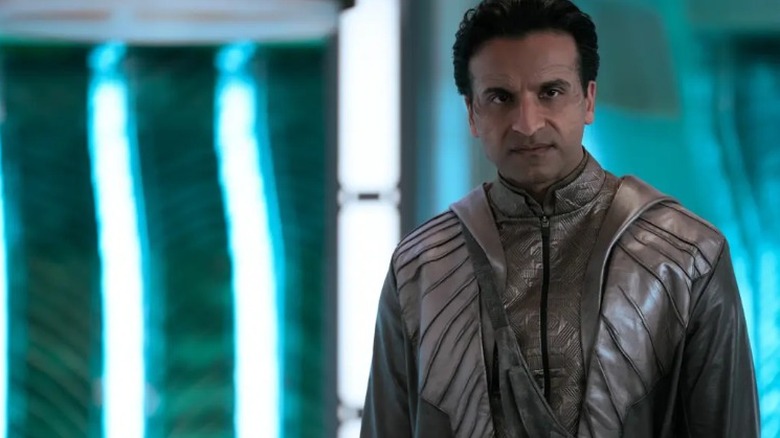The Classic Sci-Fi Short Story You Should Read After This Week's Star Trek: Strange New Worlds
This post contains spoilers for episode 6 of "Star Trek: Strange New Worlds."
It's only been on the air for a little over a month, yet "Star Trek: Strange New Worlds" is already known for its deep cut pop culture references. The wildly entertaining "Star Trek: The Original Series" prequel show has already thrown it back to everything from "The Day the Earth Stood Still" to William Shatner in a mustache.
The show has also established itself as carrying the torch Gene Roddenberry's original series lit, by asking big, bold questions about the nature of existence and providing thoughtful and complex answers. This week, though, the crew of the Enterprise tackled a philosophical question that has no easy answer — one that's been referenced by great writers and thinkers for generations.
In episode six of "Star Trek: Strange New Worlds," titled "Lift Us Where Suffering Cannot Reach," Captain Pike (Anson Mount) encounters an old flame, a woman named Alora (Lindy Booth) who is now guarding a special child called The First Servant (Ian Ho). As with many classic Trek episodes, the Enterprise team finds a group in distress and offers to help them without knowing all the details of their backstory. Longtime fans of the franchise were likely less-than-surprised when the story beats continued to follow Trek tradition, with Alora only being revealed as a villain once she and Pike had rekindled their romance.
The truth about Ascension
Yet the bleak endnote of "Lift Us Where Suffering Cannot Reach" is a little less expected. The entire episode sees the Majalans around The First Servant treating him as precious, and all indications point to him being coronated as their leader soon — so long as he doesn't get kidnapped by a fringe group first. Except, in the episode's final moments, we learn that the Enterprise crew has it all wrong. The First Servant's ascension isn't to a throne, but to a secluded and ritualistic torture chamber. The child is locked into a machine where his life force will be sucked out and used to power the luxurious lifestyles of all who live above. A small skeleton lets us know he's not the first kid to receive this fate.
As shocking as this turn of events might be, the story "Star Trek: Strange New Worlds" is telling has roots in a classic science fiction work. Prolific and celebrated sci-fi author Ursula K. Le Guin was known for creating riveting speculative stories that asked big questions about the universe. Few were more haunting or sobering than her 1973 short story, "The Ones Who Walk Away From Omelas." Le Guin called her story "Variations on a theme by William James," referencing a philosopher who wrote about the idea of a scapegoat in "The Moral Philosopher and the Moral Life." Scholars including Shoshana Knapp have also pointed out that a similar idea is communicated in Fyodor Dostoevsky's "The Brothers Karamazov," meaning the concept explored in this week's "Trek" episode goes back at least until 1880.
A utopia with a caveat
But it's the ominous, near-utopic world of "The Ones Who Walk Away From Omelas" that "Star Trek: Strange New World" clearly pulls from. Though the team behind "Star Trek: Strange New Worlds" doesn't seem to have acknowledged the Omelas homage yet, franchise executive producer Alex Kurtzman has referenced Omelas before in a conversation with TrekMovie.com about "Star Trek: Discovery." A ship in that series is even named the Le Guin.
In the brief story, Le Guin describes a perfect world called Omelas, where residents celebrate the Festival of Summer. The people were happy, sophisticated, and never wanted for anything. They were also "without monarchy and slavery, so they also got on without the stock exchange, the advertisement, the secret police, and the bomb." But Omelas had a secret, one that exactly matches up with the devastating reveal that stops Pike in his tracks in this week's episode.
A few pages into her vision of utopia, Le Guin reveals a sick twist: in a secluded place somewhere beneath the city's sleek surface, there's a child locked in a room. The child lives in filth and poverty, deprived of basic human rights. We don't know much about its history, except that it was once taken from its parents. Yet we get the sense that it needs to be there, suffering, for everyone else to continue on with their joy.
A new spin on Omelas
Even more upsetting, the story proposes that not only is the child necessary to Omelas' success, but that everyone on the planet knows about it. Le Guin writes:
"They all know that it has to be there. Some of them understand why, and some do not, but they all understand that their happiness, the beauty of their city, the tenderness of their friendships, the health of their children, the wisdom of their scholars, the skill of their makers, even the abundance of their harvest and the kindly weathers of their skies, depend wholly on this child's abominable misery."
"The Ones Who Walk Away From Omelas" is incredibly dark. It confronts readers with the idea that people everywhere are living happily while someone else suffers, and are compartmentalizing that suffering to continue on with their own joy. The latest episode of "Star Trek: Strange New Worlds" is also the darkest of the series to date, but by recontextualizing an Omelas-like story as a single planet in a whole vase universe, it's decidedly less grim. There are everyday people who risk their lives trying to save The First Servant. The Enterprise crew, for all their cultural misunderstanding, also has his best interests in mind.
Le Guin writes about those people, too. Her story ends with a reference to its title, revealing in its final paragraph that there are a lonely few who don't sit with the knowledge of Omelas' awful custom. Instead, they just leave. "The place they go towards is a place even less imaginable to most of us than the city of happiness," Le Guin writes, but, "they seem to know where they are going."
The moral challenge of Strange New Worlds
The story of the Majalans and The First Servant is unshakable and disturbing, but it's also "Star Trek" at its most impressively challenging. After the Ascension, Pike confronts Alora, asking her how she can live with the fact that her "whole civilization is founded on the suffering of a child." She counters that the Federation worlds have suffering children too, but that the privileged look away from them. "The only difference is we don't look away," she says.
In the end, Pike says he'll report the Majalans to Starfleet, despite the fact that they're not under its jurisdiction. Elder Gamal (Huse Madhavji), who tried to save The First Servant, vows to save the next one. It's not a win by any means, but like much of "Star Trek: Strange New Worlds," it's a resolution that values the real, difficult, sometimes painful work of trying to make the world safer and more equitable for everyone. Just as the end of Le Guin's story can be read multiple ways, whether this morally complicated conclusion is more pragmatic or tragic is for viewers to decide. The Enterprise crew may have walked away from the Majalan, but their mission continues on.
